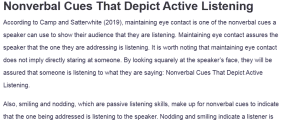Nonverbal Cues That Depict Active Listening
According to Camp and Satterwhite (2019), maintaining eye contact is one of the nonverbal cues a speaker can use to show their audience that they are listening. Maintaining eye contact assures the speaker that the one they are addressing is listening. It is worth noting that maintaining eye contact does not imply directly staring at someone. By looking squarely at the speaker’s face, they will be assured that someone is listening to what they are saying: Nonverbal Cues That Depict Active Listening.
Also, smiling and nodding, which are passive listening skills, make up for nonverbal cues to indicate that the one being addressed is listening to the speaker. Nodding and smiling indicate a listener is absorbing enough of a speaker’s words to stay in a conversation. For instance, if a speaker says something that interests the audience (say one person), nodding affirmatively assures the speaker that they are being listened to and will likely continue with the conversation. Also, nodding and smiling act as positive reinforcement, showing the speaker that their words matter and have been well received; hence, they should continue speaking.
Moreover, silent pauses between conversations are a great way for an audience to show that they are listening. Whether the audience is a single individual or a multitude, they should pause before verbally presenting their viewpoints. Pausing shows that one is actively engaged in the conversation and understands what the speaker is saying (Camp & Satterwhite, 2019).
Doing otherwise, which is to offer one’s voice immediately after a speaker completes their speech or is done speaking, may indicate an anticipation of the opportunity to speak without actually listening to what the speaker is saying. For instance, in a workplace office meeting, the audience should pause for a while and review their notes before inquiring, even when they are prompted by the speaker.
Also, natural hand and facial gestures can go a long way to show that an audience is listening to the speaker. For instance, natural hand gestures like a thumbs up will show the speaker that a listener heard what was said and is engaged in a conversation. In the same breath, facial gestures can indicate that a listener is keenly following a conversation.
For instance, if a speaker says something interesting, a listener should respond by raising their eyebrows as a sign that they are listening and approve of what was said (Camp & Satterwhite, 2019). Gestures also act as positive reinforcements to assure speakers that they are being listened to and encourage them to continue speaking. Gestures can be used to express many things, but their usage primarily conveys agreement.
Postures can also send strong messages regarding one’s attentiveness. Posture refers to the positioning of the body while seated or standing. One may stand or sit upright or lean forward to indicate that they are listening (Camp & Satterwhite, 2019). For instance, if one is staring at their computer in an open office and a manager walks in and starts talking, they should raise their head and sit upright.
The same applies if one is standing, albeit not in an upright position. Standing or sitting upright assures the speaker that they have drawn the audience’s attention and can start speaking (Camp & Satterwhite, 2019). Also, leaning forward indicates increased interest in a conversation. Therefore, if one is part of an audience, one should avoid leaning backward since that shows disinterest.
References
Camp, S. C., & Satterwhite, M. L. (2019). College English and business communication. Mcgraw-Hill Education.
ORDER A PLAGIARISM-FREE PAPER HERE
We’ll write everything from scratch
Question
- Describe 5 ways in which you can use nonverbal cues to show speakers that you are listening to them, and provide an example of each
Nonverbal Cues That Depict Active Listening


